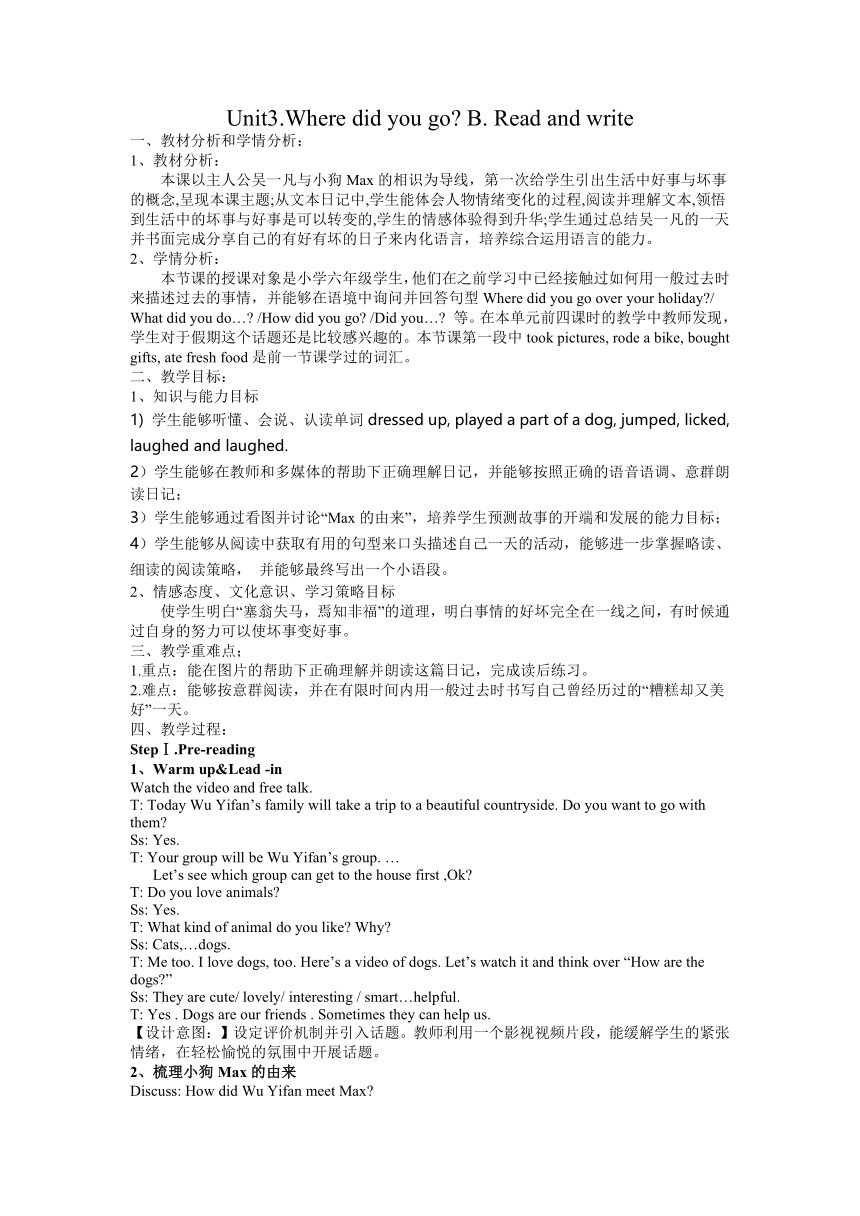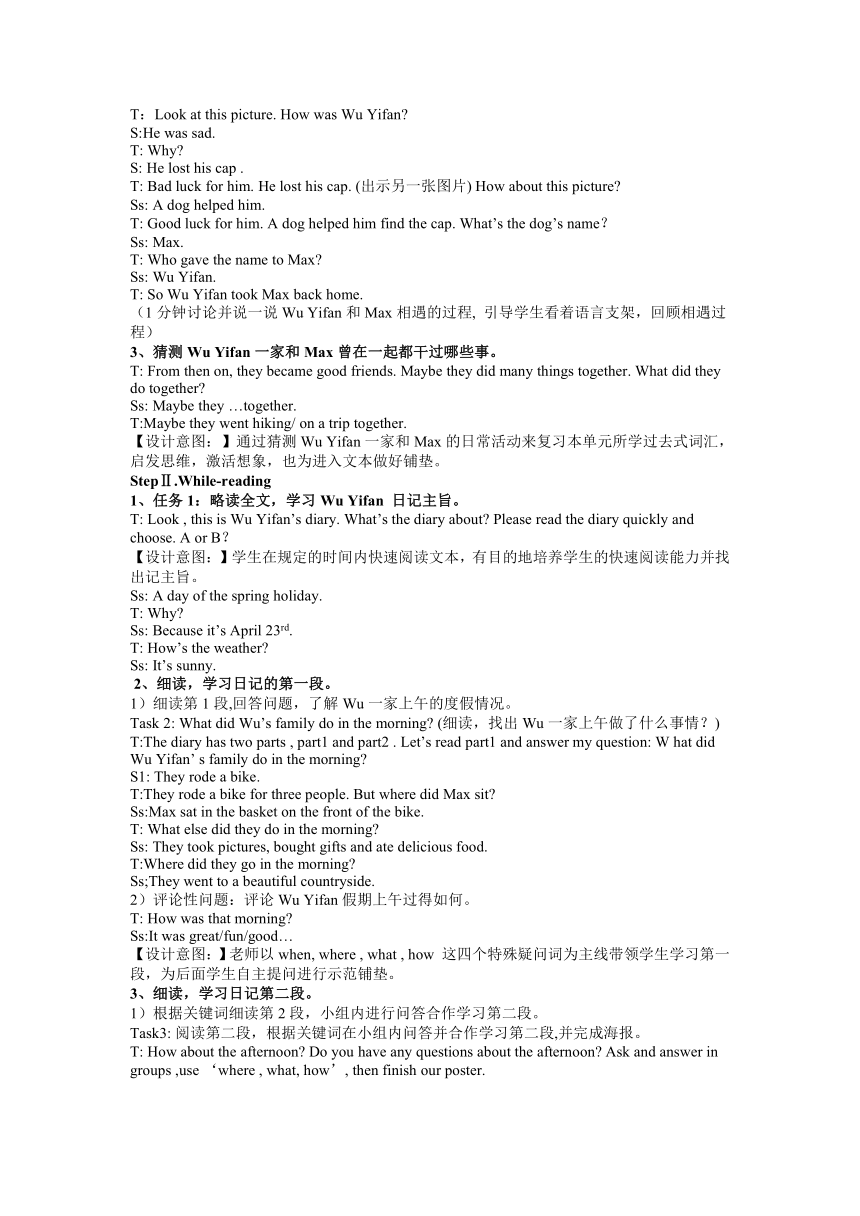Unit 3 Where did you go ?Part B Read and write 教案
文档属性
| 名称 | Unit 3 Where did you go ?Part B Read and write 教案 |  | |
| 格式 | docx | ||
| 文件大小 | 31.8KB | ||
| 资源类型 | 教案 | ||
| 版本资源 | 人教版(PEP) | ||
| 科目 | 英语 | ||
| 更新时间 | 2022-02-27 21:18:35 | ||
图片预览


文档简介
Unit3.Where did you go B. Read and write
一、教材分析和学情分析:
1、教材分析:
本课以主人公吴一凡与小狗Max的相识为导线,第一次给学生引出生活中好事与坏事的概念,呈现本课主题;从文本日记中,学生能体会人物情绪变化的过程,阅读并理解文本,领悟到生活中的坏事与好事是可以转变的,学生的情感体验得到升华;学生通过总结吴一凡的一天并书面完成分享自己的有好有坏的日子来内化语言,培养综合运用语言的能力。
2、学情分析:
本节课的授课对象是小学六年级学生,他们在之前学习中已经接触过如何用一般过去时来描述过去的事情,并能够在语境中询问并回答句型Where did you go over your holiday / What did you do… /How did you go /Did you… 等。在本单元前四课时的教学中教师发现,学生对于假期这个话题还是比较感兴趣的。本节课第一段中took pictures, rode a bike, bought gifts, ate fresh food是前一节课学过的词汇。
二、教学目标:
1、知识与能力目标
1) 学生能够听懂、会说、认读单词dressed up, played a part of a dog, jumped, licked, laughed and laughed.
2)学生能够在教师和多媒体的帮助下正确理解日记,并能够按照正确的语音语调、意群朗读日记;
3)学生能够通过看图并讨论“Max的由来”,培养学生预测故事的开端和发展的能力目标;
4)学生能够从阅读中获取有用的句型来口头描述自己一天的活动,能够进一步掌握略读、细读的阅读策略, 并能够最终写出一个小语段。
2、情感态度、文化意识、学习策略目标
使学生明白“塞翁失马,焉知非福”的道理,明白事情的好坏完全在一线之间,有时候通过自身的努力可以使坏事变好事。
三、教学重难点;
1.重点:能在图片的帮助下正确理解并朗读这篇日记,完成读后练习。
2.难点:能够按意群阅读,并在有限时间内用一般过去时书写自己曾经历过的“糟糕却又美好”一天。
四、教学过程:
StepⅠ.Pre-reading
1、Warm up&Lead -in
Watch the video and free talk.
T: Today Wu Yifan’s family will take a trip to a beautiful countryside. Do you want to go with them
Ss: Yes.
T: Your group will be Wu Yifan’s group. …
Let’s see which group can get to the house first ,Ok
T: Do you love animals
Ss: Yes.
T: What kind of animal do you like Why
Ss: Cats,…dogs.
T: Me too. I love dogs, too. Here’s a video of dogs. Let’s watch it and think over “How are the dogs ”
Ss: They are cute/ lovely/ interesting / smart…helpful.
T: Yes . Dogs are our friends . Sometimes they can help us.
【设计意图:】设定评价机制并引入话题。教师利用一个影视视频片段,能缓解学生的紧张情绪,在轻松愉悦的氛围中开展话题。
2、梳理小狗Max的由来
Discuss: How did Wu Yifan meet Max
T:Look at this picture. How was Wu Yifan
S:He was sad.
T: Why
S: He lost his cap .
T: Bad luck for him. He lost his cap. (出示另一张图片) How about this picture
Ss: A dog helped him.
T: Good luck for him. A dog helped him find the cap. What’s the dog’s name?
Ss: Max.
T: Who gave the name to Max
Ss: Wu Yifan.
T: So Wu Yifan took Max back home.
(1分钟讨论并说一说Wu Yifan和Max相遇的过程, 引导学生看着语言支架,回顾相遇过程)
3、猜测Wu Yifan一家和Max曾在一起都干过哪些事。
T: From then on, they became good friends. Maybe they did many things together. What did they do together
Ss: Maybe they …together.
T:Maybe they went hiking/ on a trip together.
【设计意图:】通过猜测Wu Yifan一家和Max的日常活动来复习本单元所学过去式词汇,启发思维,激活想象,也为进入文本做好铺垫。
StepⅡ.While-reading
1、任务1:略读全文,学习Wu Yifan 日记主旨。
T: Look , this is Wu Yifan’s diary. What’s the diary about Please read the diary quickly and choose. A or B?
【设计意图:】学生在规定的时间内快速阅读文本,有目的地培养学生的快速阅读能力并找出记主旨。
Ss: A day of the spring holiday.
T: Why
Ss: Because it’s April 23rd.
T: How’s the weather
Ss: It’s sunny.
2、细读,学习日记的第一段。
1)细读第1段,回答问题,了解Wu一家上午的度假情况。
Task 2: What did Wu’s family do in the morning (细读,找出Wu一家上午做了什么事情?)
T:The diary has two parts , part1 and part2 . Let’s read part1 and answer my question: W hat did Wu Yifan’ s family do in the morning
S1: They rode a bike.
T:They rode a bike for three people. But where did Max sit
Ss:Max sat in the basket on the front of the bike.
T: What else did they do in the morning
Ss: They took pictures, bought gifts and ate delicious food.
T:Where did they go in the morning
Ss;They went to a beautiful countryside.
2)评论性问题:评论Wu Yifan假期上午过得如何。
T: How was that morning
Ss:It was great/fun/good…
【设计意图:】老师以when, where , what , how 这四个特殊疑问词为主线带领学生学习第一段,为后面学生自主提问进行示范铺垫。
3、细读,学习日记第二段。
1)根据关键词细读第2段,小组内进行问答合作学习第二段。
Task3: 阅读第二段,根据关键词在小组内问答并合作学习第二段,并完成海报。
T: How about the afternoon Do you have any questions about the afternoon Ask and answer in groups ,use ‘where , what, how’, then finish our poster.
【设计意图:】有意培养学生提问的学习策略和小组合作学习的自学能力。小组成员问答,组长记录。
T: Ok, who has questions Who can answer her/his question …
【设计意图:】汇报学习结果,学生提问并回答,老师请学生生成板书。
2)操练句型:…wanted to do sth ; ____played the part of a ______
T: If you were Wu Yifan, what did you want to do for your mum
S1: I wanted to sing nice songs for mum.
S2: I wanted to cook for her. …
T:Dad and Wu Yifan wanted to make mum happy. So they …dressed up and made a funny play.
Who played the part of a tree What about dad Robin
T:What about Max What did Max do
T:He jumped on Robin and licked him.
【设计意图:】在学生问答过程中利用超级链接解读操练文本中较难的句型:I wanted to…;We dressed up and made a funny play. ____played the part of a ______.通过分享照顾生病妈妈的经验,适时关注了情感体验。
3)Number the pictures.
T: Let’s number the pictures according to the diary on this paper.
Check答案之后,带领学生梳理吴一凡一家情绪的变化过程。
T: Look at the first picture. How did they feel in the morning
Ss: They were happy.
T:Then How did they feel when Mum didn’t feel well
Ss: They were sad and worried.
T:How did they feel at last?
Ss:They were very happy.
T:So how was that day?
Ss: It was great. /It was a bad but also a good day.
T: Yes. Bad luck often brings good luck.
【设计意图:】小结全文,用总结句和板书来梳理文章的脉络;培养学生学习一种新的归纳策略。
4、文本朗读。
Task 6: Read it better.(朗读更进一步。)
全文听一遍,第二遍请学生合着录音读,最后自由朗读1分钟。
T: Let’s read the bad but good day one more time. Read it better . Pay more attention to the stress, intonation ,
liaison and pause. Just like this :In the morning, we rode a bike for three people. First time, just listen. Second time, let’s follow it. Last, read it by yourselves.
【设计意图:】通过不同层次的听音与朗读练习,培养学生按意群朗读的良好习惯。
5、复述文本。
T:Who can retell Wu Yifan’s bad but also good day for us Maybe the blackboard writing can help you.
【设计意图:】让学生学着用一般过去时描述事情,帮助学生完整梳理文本,为下一步的书写输出做准备。
StepⅢ.Post-Reading
1、教师说说自己曾有的一天,并做好书写前指导。
T:Yes. Bad luck often brings good luck. Do you agree with that I agree because I often have some bad but good days. Today was a bad but good day for me….
T:That was my day .Did you have a bad but also a good day
Ss:Yes.
T: Maybe you had a cold, hurt your foot, fell off your bike…
T:Try to write it down on this paper.
2、完成课本练习,书写自己糟糕但又美好的一天。
3、展示个别同学自己曾遭遇过“糟糕却又美好”的一天。
4、通过呈现谚语"Bad luck often brings good luck."来小结本节课。
T:What do you learn from this lesson
S:Bud luck often brings good luck!
5、Homework:
1)Talk about your bad but good day with your friends.
2)Write a short diary about the day.
Unit3. Where did you go?
Read and write
In the afternoon when in the morning
countryside where hotel
didn’t feel well rode a bike
stayed in the hotel Wu’s family took pictures
dressed up bought gifts
made a funny play what ate delicious food
jumped and licked him
bad how good
一、教材分析和学情分析:
1、教材分析:
本课以主人公吴一凡与小狗Max的相识为导线,第一次给学生引出生活中好事与坏事的概念,呈现本课主题;从文本日记中,学生能体会人物情绪变化的过程,阅读并理解文本,领悟到生活中的坏事与好事是可以转变的,学生的情感体验得到升华;学生通过总结吴一凡的一天并书面完成分享自己的有好有坏的日子来内化语言,培养综合运用语言的能力。
2、学情分析:
本节课的授课对象是小学六年级学生,他们在之前学习中已经接触过如何用一般过去时来描述过去的事情,并能够在语境中询问并回答句型Where did you go over your holiday / What did you do… /How did you go /Did you… 等。在本单元前四课时的教学中教师发现,学生对于假期这个话题还是比较感兴趣的。本节课第一段中took pictures, rode a bike, bought gifts, ate fresh food是前一节课学过的词汇。
二、教学目标:
1、知识与能力目标
1) 学生能够听懂、会说、认读单词dressed up, played a part of a dog, jumped, licked, laughed and laughed.
2)学生能够在教师和多媒体的帮助下正确理解日记,并能够按照正确的语音语调、意群朗读日记;
3)学生能够通过看图并讨论“Max的由来”,培养学生预测故事的开端和发展的能力目标;
4)学生能够从阅读中获取有用的句型来口头描述自己一天的活动,能够进一步掌握略读、细读的阅读策略, 并能够最终写出一个小语段。
2、情感态度、文化意识、学习策略目标
使学生明白“塞翁失马,焉知非福”的道理,明白事情的好坏完全在一线之间,有时候通过自身的努力可以使坏事变好事。
三、教学重难点;
1.重点:能在图片的帮助下正确理解并朗读这篇日记,完成读后练习。
2.难点:能够按意群阅读,并在有限时间内用一般过去时书写自己曾经历过的“糟糕却又美好”一天。
四、教学过程:
StepⅠ.Pre-reading
1、Warm up&Lead -in
Watch the video and free talk.
T: Today Wu Yifan’s family will take a trip to a beautiful countryside. Do you want to go with them
Ss: Yes.
T: Your group will be Wu Yifan’s group. …
Let’s see which group can get to the house first ,Ok
T: Do you love animals
Ss: Yes.
T: What kind of animal do you like Why
Ss: Cats,…dogs.
T: Me too. I love dogs, too. Here’s a video of dogs. Let’s watch it and think over “How are the dogs ”
Ss: They are cute/ lovely/ interesting / smart…helpful.
T: Yes . Dogs are our friends . Sometimes they can help us.
【设计意图:】设定评价机制并引入话题。教师利用一个影视视频片段,能缓解学生的紧张情绪,在轻松愉悦的氛围中开展话题。
2、梳理小狗Max的由来
Discuss: How did Wu Yifan meet Max
T:Look at this picture. How was Wu Yifan
S:He was sad.
T: Why
S: He lost his cap .
T: Bad luck for him. He lost his cap. (出示另一张图片) How about this picture
Ss: A dog helped him.
T: Good luck for him. A dog helped him find the cap. What’s the dog’s name?
Ss: Max.
T: Who gave the name to Max
Ss: Wu Yifan.
T: So Wu Yifan took Max back home.
(1分钟讨论并说一说Wu Yifan和Max相遇的过程, 引导学生看着语言支架,回顾相遇过程)
3、猜测Wu Yifan一家和Max曾在一起都干过哪些事。
T: From then on, they became good friends. Maybe they did many things together. What did they do together
Ss: Maybe they …together.
T:Maybe they went hiking/ on a trip together.
【设计意图:】通过猜测Wu Yifan一家和Max的日常活动来复习本单元所学过去式词汇,启发思维,激活想象,也为进入文本做好铺垫。
StepⅡ.While-reading
1、任务1:略读全文,学习Wu Yifan 日记主旨。
T: Look , this is Wu Yifan’s diary. What’s the diary about Please read the diary quickly and choose. A or B?
【设计意图:】学生在规定的时间内快速阅读文本,有目的地培养学生的快速阅读能力并找出记主旨。
Ss: A day of the spring holiday.
T: Why
Ss: Because it’s April 23rd.
T: How’s the weather
Ss: It’s sunny.
2、细读,学习日记的第一段。
1)细读第1段,回答问题,了解Wu一家上午的度假情况。
Task 2: What did Wu’s family do in the morning (细读,找出Wu一家上午做了什么事情?)
T:The diary has two parts , part1 and part2 . Let’s read part1 and answer my question: W hat did Wu Yifan’ s family do in the morning
S1: They rode a bike.
T:They rode a bike for three people. But where did Max sit
Ss:Max sat in the basket on the front of the bike.
T: What else did they do in the morning
Ss: They took pictures, bought gifts and ate delicious food.
T:Where did they go in the morning
Ss;They went to a beautiful countryside.
2)评论性问题:评论Wu Yifan假期上午过得如何。
T: How was that morning
Ss:It was great/fun/good…
【设计意图:】老师以when, where , what , how 这四个特殊疑问词为主线带领学生学习第一段,为后面学生自主提问进行示范铺垫。
3、细读,学习日记第二段。
1)根据关键词细读第2段,小组内进行问答合作学习第二段。
Task3: 阅读第二段,根据关键词在小组内问答并合作学习第二段,并完成海报。
T: How about the afternoon Do you have any questions about the afternoon Ask and answer in groups ,use ‘where , what, how’, then finish our poster.
【设计意图:】有意培养学生提问的学习策略和小组合作学习的自学能力。小组成员问答,组长记录。
T: Ok, who has questions Who can answer her/his question …
【设计意图:】汇报学习结果,学生提问并回答,老师请学生生成板书。
2)操练句型:…wanted to do sth ; ____played the part of a ______
T: If you were Wu Yifan, what did you want to do for your mum
S1: I wanted to sing nice songs for mum.
S2: I wanted to cook for her. …
T:Dad and Wu Yifan wanted to make mum happy. So they …dressed up and made a funny play.
Who played the part of a tree What about dad Robin
T:What about Max What did Max do
T:He jumped on Robin and licked him.
【设计意图:】在学生问答过程中利用超级链接解读操练文本中较难的句型:I wanted to…;We dressed up and made a funny play. ____played the part of a ______.通过分享照顾生病妈妈的经验,适时关注了情感体验。
3)Number the pictures.
T: Let’s number the pictures according to the diary on this paper.
Check答案之后,带领学生梳理吴一凡一家情绪的变化过程。
T: Look at the first picture. How did they feel in the morning
Ss: They were happy.
T:Then How did they feel when Mum didn’t feel well
Ss: They were sad and worried.
T:How did they feel at last?
Ss:They were very happy.
T:So how was that day?
Ss: It was great. /It was a bad but also a good day.
T: Yes. Bad luck often brings good luck.
【设计意图:】小结全文,用总结句和板书来梳理文章的脉络;培养学生学习一种新的归纳策略。
4、文本朗读。
Task 6: Read it better.(朗读更进一步。)
全文听一遍,第二遍请学生合着录音读,最后自由朗读1分钟。
T: Let’s read the bad but good day one more time. Read it better . Pay more attention to the stress, intonation ,
liaison and pause. Just like this :In the morning, we rode a bike for three people. First time, just listen. Second time, let’s follow it. Last, read it by yourselves.
【设计意图:】通过不同层次的听音与朗读练习,培养学生按意群朗读的良好习惯。
5、复述文本。
T:Who can retell Wu Yifan’s bad but also good day for us Maybe the blackboard writing can help you.
【设计意图:】让学生学着用一般过去时描述事情,帮助学生完整梳理文本,为下一步的书写输出做准备。
StepⅢ.Post-Reading
1、教师说说自己曾有的一天,并做好书写前指导。
T:Yes. Bad luck often brings good luck. Do you agree with that I agree because I often have some bad but good days. Today was a bad but good day for me….
T:That was my day .Did you have a bad but also a good day
Ss:Yes.
T: Maybe you had a cold, hurt your foot, fell off your bike…
T:Try to write it down on this paper.
2、完成课本练习,书写自己糟糕但又美好的一天。
3、展示个别同学自己曾遭遇过“糟糕却又美好”的一天。
4、通过呈现谚语"Bad luck often brings good luck."来小结本节课。
T:What do you learn from this lesson
S:Bud luck often brings good luck!
5、Homework:
1)Talk about your bad but good day with your friends.
2)Write a short diary about the day.
Unit3. Where did you go?
Read and write
In the afternoon when in the morning
countryside where hotel
didn’t feel well rode a bike
stayed in the hotel Wu’s family took pictures
dressed up bought gifts
made a funny play what ate delicious food
jumped and licked him
bad how good
